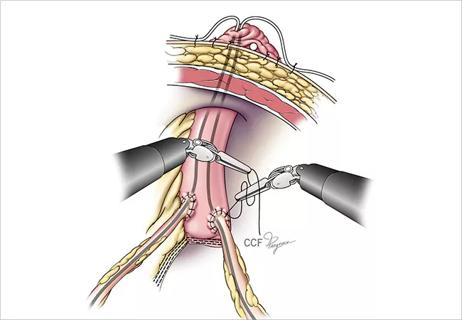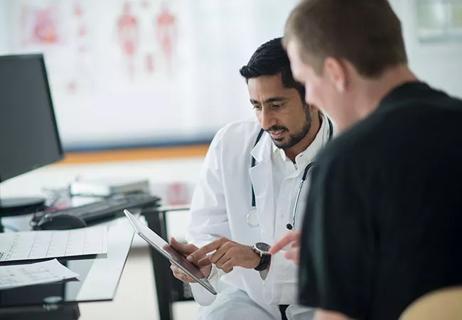
Dr. Alexopoulos and his wife, Dr. Sophia Pachydaki, share in the excitement of their oldest son’s high school graduation in downtown Cleveland.
Advertisement
Cleveland Clinic is a non-profit academic medical center. Advertising on our site helps support our mission. We do not endorse non-Cleveland Clinic products or services. Policy
Meet Andreas Alexopoulos, MD, MPH (CLNPHY’03, IN’05), a staff physician in the Epilepsy Center of the Neurological Institute at Cleveland Clinic Main Campus. Dr. Alexopoulos also has an adjunct appointment in neurosciences at the Lerner Research Institute and is the director of the year one neurosciences course at the Cleveland Clinic Lerner College of Medicine (CCLCM).
Q. What led you to a career in medicine, and specifically neurology?
A. It’s a funny story. I never gave it much thought before now, but it started with my dad who was an electrical engineer and had a management role at the public power company in Greece. When I was very young, he used to take me to the company’s headquarters and proudly show me a big map on the wall with lines and lights representing the complex grid of electrical supply to the city of Athens. It was marvelous! So as a child, I decided to become an engineer. But as I grew older, I developed an intense interest in brain-behavior relationships. I now marvel at the complex wiring of the brain and its electrical connections by reading electroencephalography signals and taking care of people with epilepsy – the prototypical electrical disorder of the brain. I hear patients’ stories and observe behaviors both in health and disease. It turned out to be the perfect fit for me.
Q. What is most gratifying to you in your current role?
A. Making a difference in the life of a person who has epilepsy – either by eliminating a person’s seizures (particularly when the individual has a drug-resistant epilepsy or has already undergone multiple unsuccessful evaluations in the past) or by reducing the burden of seizures and addressing other comorbidities that come hand in hand in people with epilepsy – is very highly and immediately rewarding.
Advertisement
Q. What motivated you to serve on the Alumni Board? How long have you served? How have you been able to contribute?
A. For me, it was the opportunity to give back to the people I trained with, learned from, and worked alongside. I have served for one year and currently am helping to update the list of alumni of the Neurological Institute, which has more than 1,000 members.

Dr. Alexopoulos considers his students and colleagues his “larger family.” He is pictured here with some of the youngest Cleveland Clinic epilepsy fellowship alumni, who are now practicing epileptologists at the Epilepsy Center of the Neurological Institute at Cleveland Clinic. From left to right are: Elizabeth (Liz) Spurgeon, MD (N’18/EPIL’21/NPHY’22), Krishna Galla, MD (EPIL’2020), Jean Khoury, MD (N’18/EPIL’21/NPHY’22), Jessica Fesler, MD (EPIL’16/NPHY’17), Jason Chisholm, MD (EPIL’22/NPHY’23), and Vineet Punia, MD (NPHY’15).
Q. What’s a work-related accomplishment that you’re proud of or a favorite memory at Cleveland Clinic?
A. I have so many good memories and many things that have been very rewarding in my work as a clinician, researcher and educator. Our work in translational research in MEG (magnetoencephalography) and stereo-EEG (intracranial stereo-electroencephalography) has been especially gratifying. That work has been published in major peer-reviewed journals – sometimes even as the cover story. More importantly, this work has led to changes in clinical practice that have directly benefited our patients. It has been exhilarating, gratifying and humbling to be part of advancements like these over the course of my career.
Advertisement
Q. Who is/are your mentor(s) and how have they taught/inspired you?
A. Many people have served as mentors to me over the years, whether consciously or unconsciously, and they continue to inspire me. I will highlight four. First, my dad during my formative years and beyond. And then, during my residency at Mount Sinai in New York City, I worked with Dr. Jim Rowan, an exquisite neurologist and epilepsy specialist, who also practiced at the VA Medical Center in the Bronx. He introduced me to EEG and the evaluation of seizures and had a major impact on my decision to focus on epilepsy, which he never knew because he passed away two years later. Then during my fellowship here, Hans Lüders, MD (N’06), a master teacher of precision, showed me how to read EEG signals and think about the origin of epileptic seizures. And finally, during and beyond my fellowship, Imad Najm, MD (IM’93/N’96/NPHY’97) who has been the embodiment of an aspirational mentor.
Q. What do you enjoy doing outside of work?
A. I enjoy spending time with my family, reading, traveling and visiting my homeland of Greece. My wife, Sophia, and I have raised two boys during our time in Cleveland, our other homeland. Vassilis is now in his third year of college, and Yannis is in third grade.
Oh, and everything about football – the one played with a proper ball, not the oval-shaped one. I’ve also recently acquired a taste for baseball.
Q. What advice would you like to share with future alumni?
A. Stay connected! Alumni are the fabric of Cleveland Clinic. Each successive generation of alumni will continue to define the good clinical and academic practice of medicine within and far beyond this institution.
Advertisement
Advertisement
Advertisement

Study shows surgical experience impacts the risk of post-operative stricture formation

Study offers evidence to guide treatment decisions

Assessments of the shorter collection routine are encouraging, but not yet definitive